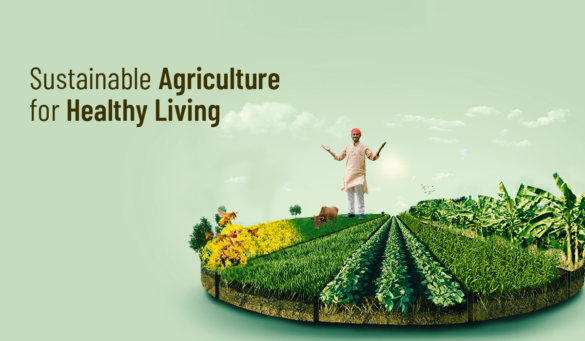Table of Contents
Sustainable agriculture seeks to balance several goals, including satisfying human food and fiber needs, enhancing natural resources and environmental quality, and providing farm families with economic viability.
It involves practices like minimizing tilling, rotating crops and embracing diversity (such as polycultures) in imitation of natural ecosystems. It also emphasizes limiting the use of toxic pesticides by encouraging organisms that prey on crop-destroying insects.
Water
The global agriculture sector uses about half of the world’s fresh water, but climate change and competition for water with other sectors such as industry and recreation threaten sustainable farming. Sustainable agriculture practices promote better management of limited water resources and protection of ecosystems that are essential to water quality.
Farmers using sustainable practices focus on increasing the resilience of their farms to withstand extreme weather events, such as droughts or floods, and to minimize pollution from fertilizers and pesticides that run off the land. They may also use methods that keep soil healthy and teeming with living organisms, which helps hold water like a sponge and provides nutrients to crops and livestock.
Many sustainable farmers rely on water-efficient irrigation systems, which reduces the need to mine water from rivers or other bodies of water. They may replant riparian or water-friendly trees to help restore and stabilize water banks. They may also use rainwater harvesting techniques to capture and store water for use in irrigation. In addition, they may use cover crops to reduce erosion and nutrient runoff. Sustainable agricultural methods also promote reducing the use of non-renewable natural resources such as fossil fuels, and they are encouraged to recycle plant residues and animal waste. This translates into reduced energy costs and greenhouse gas emissions.
Soil
The soil is a dynamic living system and vital part of the Earth. It delivers multiple ecosystem services that are essential to human wellbeing and the achievement of the United Nations Sustainable Development Goals (SDGs). However, human activity is threatening the capacity of the soil to perform these functions:
Soil is far more than just dirt: it contains mineral particles, organic materials, air, water, and living organisms that interact slowly but constantly. It varies widely from one place to another, even within a single field or a single layer.
Sustainable farming practices can help to maintain and enhance soil health. For example, crop rotation can be used to reduce soil depletion by changing the type of plant grown in a field each year. This can improve soil fertility and biodiversity, as well as cut pesticide and fertilizer use.
Another way to protect the soil is through windbreaks, which are natural or manmade barriers that reduce the abrasive effect of wind on the soil and growing plants. The Anishinabe tribes, for example, practice a form of sustainable harvesting known as “the Honorable Harvest.” This practice involves following several rules when gathering a plant, such as never taking the first or last of the plant. This helps to conserve the plant and prevent its eventual extinction in the area.
Energy
In sustainable agriculture, stewardship of natural and human resources is a top priority. That means considering the needs of future generations along with maximizing yields and economic returns. Sustainable farming practices seek to minimize harm to animals and ecosystems, preserve natural resources, and provide a high standard of living for farmers and their families.
Many of the same natural systems that support agricultural production also are important energy resources. For example, agroecosystems depend on soil to cycle essential nutrients, such as nitrogen and phosphorus. Because global reserves of these minerals are limited, developing alternatives to chemical fertilizers is a key aspect of sustainable agriculture. These alternatives include recycling of these nutrients at the farm and regional levels, using organic nutrient sources (such as animal and green manures), and restoring agroecosystem health through improved soil management practices.
Another energy source is water, which is used for irrigation and as a vehicle for pesticides and herbicides in conventional agriculture. Water scarcity is a worldwide problem, and sustainable agriculture can help address it by reducing water usage and improving water quality. Planting riparian or “water-friendly” trees helps reduce erosion and prevent polluted runoff from entering rivers and streams, and using energy-efficient technologies like precision ag equipment can further decrease water use. One exciting new energy resource for agriculture is agrivoltaics, in which solar panels and cropland work together to generate electricity. This clean energy can power electric tractors and harvesters, and the excess can be sent back to the grid for residential use.
Animal Welfare
With the earth’s population expanding rapidly, sustainable agriculture is a means of producing enough food for everyone with limited natural resources. Sustainable farmers try to conserve water and keep the environment clean by finding new ways of using existing resources. One example is planting natural tree buffers along waterways. The trees help reduce erosion and prevent runoff that may pollute the soil or water.
A sustainable farmer is aware of the impact their farming practices have on the surrounding environment, including the animal population. They avoid overusing non-renewable resources, especially those that could potentially harm their animals. In addition, they try to find innovative methods of utilizing the waste products from their animals. For example, they may use the manure to make fertilizer or even for electricity. This reduces the amount of waste that is sent to landfills and helps keep the earth healthy.
Often, when the term sustainability is used in the context of animal welfare, it is interpreted as a form of environmentalism. However, using this word in this way can confuse the motives of those advocating for sustainable agriculture and animal welfare. The two concepts have different aims and require a distinct set of considerations to be addressed effectively. The use of the word sustainability in this way could also blur the boundaries between anthropocentric animal welfare and environmental concerns.

